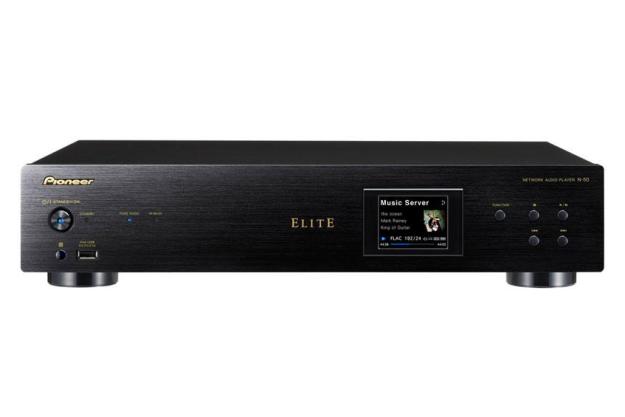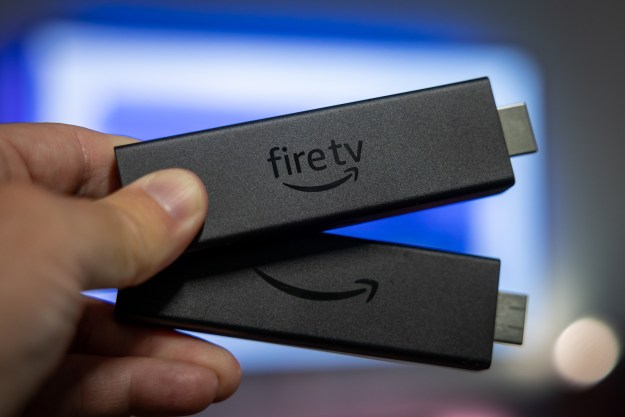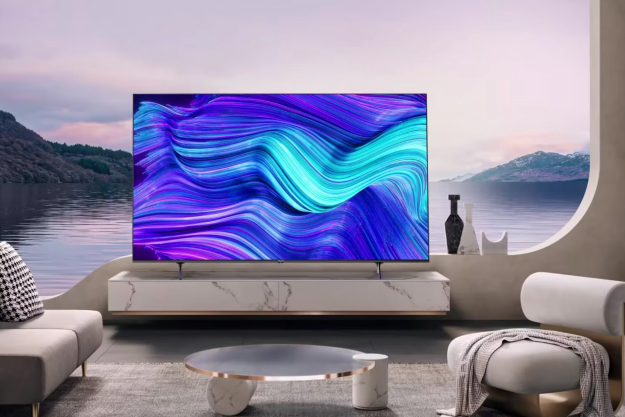
“Pioneer’s N-50 is a very good networked audio player for critical listeners who prefer discrete audio components over integrated receivers.”
- Excellent sound and build quality
- Supports Apple AirPlay
- USB Type A and B ports
- FLAC support
- No support for Apple Lossless or WMA Lossless
- No headphone output
- Doesn’t support subscription music services such as Pandora
Pioneer’s N-50 Elite networked audio player is unlikely to hold much interest if you already own a mid-range A/V receiver of recent vintage. That’s because the N-50 duplicates much of a receiver’s networking and conversion functionality. But if you prefer to stock your entertainment center with discrete, purpose-built audio components—a dedicated amp, pre-amp, and outboard DAC, for example — the N-50 is very much worthy of consideration. That goes double if you store your digital music on a PC, NAS box, or server.
The N-50 is designed to be your audio system’s digital nerve center. This substantial component houses a AKM Semiconductor AK4480 (a 24-bit/192kHz digital-to-analog converter, or DAC), wired Ethernet, digital inputs and outputs (coaxial, optical, and USB type A and B), and a pair of stereo analog outputs. Added-cost options render it capable of wireless networking (with Pioneer’s AS-WL300, $140) and Bluetooth audio streaming (with Pioneer’s AS-BT200, $90). One feature that’s curiously missing is a headphone output (if this is a feature you require, take a look at Marantz’s $799 NA7004).
Out of the box
Did we mention the N-50 is substantial? The device tips the scales at 16.1 pounds, thanks in large part to the presence of twin EL transformers (one analog and one digital, to reject external interference) and a thick steel plate secured to the bottom of the chassis to isolate it from vibration. The heavy-duty power cord is removable, in the event you’d prefer an audiophile cable.
Pioneer’s networked audio player is outfitted with a 2.5-inch color display (320 x 240 resolution), which can display album art as long as its embedded in the file, and five buttons for menu navigation and playback. There’s a small remote control, too; but you’ll be better served by Pioneer’s free tablet and smartphone apps (supporting both iOS and Android) or whatever media player is installed on your computer. Anyone with a substantial music library will quickly tire of repeatedly mashing the multi-function buttons to find the album or track you want to hear. The touch-screen apps are also much more intuitive to use than the front-panel controls. Pioneer’s Air Jam app, which requires the aforementioned Bluetooth adapter to function, is great fun to use — especially at parties. Install the app on up to four smartphones or tablets, and you and three friends can collaboratively create playlists in real time using music stored on any of the four devices.
Audio Sources
Thanks to its plethora of inputs, the N-50 can decode music streams from just about any source. In addition to being DLNA 1.5 certified, it’s compatible with Apple’s AirPlay protocol, so it can support wireless music streaming from a Mac, iPod, iPad, or iPhone (although you’ll also need Pioneer’s Wi-Fi adapter unless you have a hardwired Ethernet port nearby). While Wi-Fi will cost you $140, it’s a feature you can’t get at any price with Marantz’s NA7004, short of deploying a wireless Ethernet bridge.
Android and iOS users can plug their smartphone or tablet directly into the USB Type A port on the N-50’s front panel — no docking station required — or stream music to the optional Bluetooth adapter. This USB port can also host USB thumb drives, as long as they’re formatted as either FAT16 or FAT32; the N-50 can’t recognize storage devices formatted as NTFS, nor does it support mechanical USB hard drives.
If you own a home-theater PC or a notebook, you can connect it to the N-50’s rear-panel USB Type B port and use the N-50 to convert the PC’s audio bit stream to analog (the N-50 will not, however, pass this bit stream through to its digital outputs, presumably for the purposes of digital rights management). Using your PC’s USB port, as opposed to its optical or coaxial S/PDIF outputs, means you can stream higher-resolution bit streams (up to 32 bit) at higher sampling rates (up to 192kHz). S/PDIF is typically limited to a maximum resolution and sampling rate of 20 bits and 48kHz, respectively. The N-50 also supports asynchronous USB transfer mode, which means that the N-50 uses its own digital clock instead of the PC’s, to eliminate jitter.

The N-50 supports a broad range of audio codecs, including AAC, FLAC, LPCM, MP3, WAV, and WMA (Pioneer’s website incorrectly reports that the player supports Ogg Vorbis files, too). On the down side, it does not support WMA Lossless or Apple Lossless; nor does it support bit streams from SACD and DVD-Audio players. If you’re intimately familiar with AirPlay, you’re probably wondering how it can support that protocol without supporting Apple Lossless (since AirPlay converts any track to Apple Lossless before it streams it over the network). The BridgeCo chip that delivers AirPlay support is capable of decoding lossless codecs, so we’re guessing the same chip handles the task instead of the DAC. Our contact at Pioneer didn’t know and had to put the question to an engineer in Japan, so we’ll update this story when we find out.
When you tire of listening to your own music collection, you can switch to Internet radio. Pioneer uses the vTuner platform, but you can log into Pioneer’s website to add any stations not found in vTuner’s database. And since there’s an embarrassment of riches when it comes to Internet radio, you can create your own “favorites” list with up to 20 presets. We were surprised, however, to discover that the N-50 doesn’t support subscription-music services such as Pandora, Rhapsody, and Slacker. While Pioneer correctly points out that you can run these services on your computer and stream the audio over USB or your network, doing so requires you to manage two different machines (the computer and the N-50). We think Marantz has the better idea on this count with their NA7004 network audio player (although it doesn’t support Slacker).
Performance
We connected the N-50’s analog outputs to an Onkyo TX-NR709 receiver, which drives a pair of Klipsch RF-35 tower speakers (supplemented by a Boston Acoustics PV-800 subwoofer). We streamed FLAC files over USB from an ASRock home-theater PC, FLAC and MP3 files from a Windows Home Server machine on our network, and AAC files from an iPod Touch (using both AirPlay and the optional Bluetooth dongle).
Listening to “Burnin’ Blue” (ripped from the Paul Thorn CD A Long Way from Tupelo, encoded to FLAC, and stored on our home server), we found the N-50’s digital-to-analog conversion just a little more appealing to our ears. Thorn’s bluesy ballad sounded slightly warmer played through the N-50’s AKM Semiconductor AK4480 DAC than it did with TX-NR709, which utilizes a Burr-Brown PCM1690 DAC; but as we pointed out in the opener, anyone considering the N-50 would be unlikely to use it with an AV receiver such as this, favoring a discrete amplifier instead.

The N-50 offers four playback modes: Auto Sound Retriever, Sound Retriever Air Hi-bit 32, and Pure Audio. With Auto Sound Retriever, the signal is routed through a digital signal processor (DSP) in an effort to restore some of the quality that is lost when tracks are compressed with lossy codecs, such as MP3. As such, it’s particularly useful when listening to Internet radio stations, which tend to stream at relatively low bit rates. Sound Retriever Air does the same for audio signals streamed over Bluetooth. We found that both these modes helped restore life to compressed files.
In Hi-bit 32 mode, 16- and 24-bit bit streams are upsampled in real time to 32-bit resolution before being converted to analog. We auditioned this with Peter Gabriel’s luscious cover of David Bowie’s “Heroes,” from Gabriel’s Scratch My Back album. The version we used is a little unusual in that it was encoded in 24-bit FLAC. The entire album sounds absolutely amazing (it’s included in Bowers & Wilkins’ Society of Sound subscription music service), and the N-50’s Hi-bit 32 mode made it even better. But if you’re the type who wants to hear your music with as little extra processing as possible, Pure Audio mode bypasses the N-50’s digital signal processor altogether to reproduce the track with as much fidelity to the original signal as possible.
Conclusion
Pioneer’s N-50 is a very good networked audio player for critical listeners who prefer discrete audio components over integrated receivers. While it lacks a few features found in Marantz’s pricier NA7004 (namely, a headphone jack/amp, an RS-232 port, and support for subscription music services such as Pandora), Pioneer delivers superior Android and iOS apps and optional wireless networking. The N-50 is also a very good outboard DAC for most stereo sources (with the notable exception of SACD and DVD-Audio players).
Highs:
- Excellent sound and build quality
- Supports Apple AirPlay
- USB Type A and B ports
- FLAC support
Lows:
- No support for Apple Lossless or WMA Lossless
- No headphone output
- Doesn’t support subscription music services such as Pandora
Editors' Recommendations
- HEOS app refresh adds some of Sonos’ best features
- KEF’s R Series Meta speakers absorb noise like an acoustic black hole


